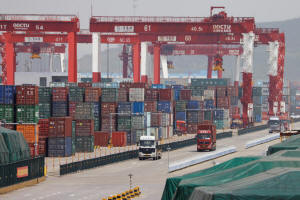Chinese economy's export pillar shows cracks from global slowdown
 Send a link to a friend
Send a link to a friend
 [September 15, 2022] By
Ellen Zhang and Ryan Woo [September 15, 2022] By
Ellen Zhang and Ryan Woo
BEIJING (Reuters) - China's exporters – the
last reliable pillar of the world's second-largest economy as it
struggled with the pandemic, weak consumption and a property crisis –
are warning of hard times ahead as softer overseas markets force them to
shed workers, shift to lower-value goods and even rent out their
factories.
Alarm bells sounded for China's $18 trillion economy when trade data
last week showed export growth well short of expectations and slowing
for the first time in four months.
Those alarms are echoing in workshops across eastern and southern
China's manufacturing hubs, in industries from machinery parts and
textiles to high-tech home appliances, where businesses are scaling back
while export orders dry up.
"It is very likely China's exports will slow further or even contract in
the coming months, as leading economic indicators point to a global
growth slowdown or even recession," said Nie Wen, a Shanghai-based
economist at Hwabao Trust.

Exports are vital to China more than ever, with all other pillars of its
economy on shaky ground. Nie estimates exports will account for 30-40%
of China's GDP growth this year, up from 20% last year, even as outbound
shipments slow.
"We had no export orders in the first eight months at all," said Yang
Bingben, 35, whose company makes industrial-use valves in eastern
China's export and manufacturing hub of Wenzhou.
He has let go all but 17 of his 150 workers and rented out most of his
7,500-square-meter (80,730 square foot) plant.
He sees little hope for the fourth quarter, typically his busiest
season, and expects sales this year to drop 50-65% from last year, with
the stalling domestic economy unable to take up any slack from the slump
in exports.
To support the sector, export tax rebates have been expanded, and a
cabinet meeting chaired by Premier Li Keqiang on Tuesday pledged support
for exporters and importers to secure orders, expand markets and improve
the efficiency of port operations and logistics.
RELIANCE ON EXPORTS
China over the years has moved to ease its economy's reliance on exports
for growth, and reduce its exposure to global factors beyond its
control, while some low-cost manufacturing has been shifting to other
countries such as Vietnam as China grows richer and its costs rise.
In the five years before the pandemic, from 2014 to 2019, the share of
exports in China's GDP shrank to 18.4% from 23.5%, according to World
Bank figures.
[to top of second column] |

Trucks are seen at a container terminal
of Qingdao port in Shandong province, China, following an oil spill
in the Yellow Sea caused by a collision between tanker A Symphony
and bulk vessel Sea Justice off the port, April 28, 2021.
REUTERS/Carlos Garcia Rawlins/File Photo

But that share edged back up with the emergence of COVID-19, reaching 20% last
year, in part as locked-down, home-bound consumers worldwide snapped up China's
electronics and household goods. That also helped to buoy China's overall
economic growth.
The pandemic has come back to bite China this year, however. Its strict efforts
to contain domestic COVID outbreaks led to lockdowns that disrupted supply
chains and shipping.
But much more ominous for exporters, they say, has been the slowdown in overseas
demand, as the pandemic's fallout and the Ukraine conflict fuel inflation and
tighter monetary policies that are depressing global growth.
"Sliding demand for robot vacuum cleaners in Europe is beyond our expectation
this year, with customers placing fewer orders and unwilling to buy expensive
products," said Qi Yong, a Shenzhen-based exporter of smart home electronics.
"Compared with 2020 and 2021, this year is the harder one, full of unprecedented
hardship," he said. While shipments picked up this month in the run-up to
Christmas, he said, sales may still drop 20% in the third quarter from a year
earlier.
He has cut 30% of his staff, to around 200, and may lay off more workers if
business conditions require it.
These retrenchments put further pressure on policymakers searching for new
sources of growth in an economy burdened by a year-long property slump and
disruptions from Beijing's zero-COVID policy.
Chinese companies involved in exporting and importing goods and services employ
one-fifth of China's workforce, supplying 180 million jobs.

Some exporters are adjusting their operations in response to the slump by
producing cheaper goods, but this too will eat into revenue.
Miao Yujie, who runs an export company in eastern China's Hangzhou, said he has
started to use cheaper raw materials and to produce lower-value electronics
goods and clothing that would appeal to inflation-wary, price-conscious
consumers.
"There will be a big drop in exports in the second half of the year," Miao said.
($1 = 6.9645 Chinese yuan renminbi)
(Reporting by Ellen Zhang and Ryan Woo; Editing by Edmund Klamann)
[© 2022 Thomson Reuters. All rights
reserved.]This material may not be published,
broadcast, rewritten or redistributed.
Thompson Reuters is solely responsible for this content. |